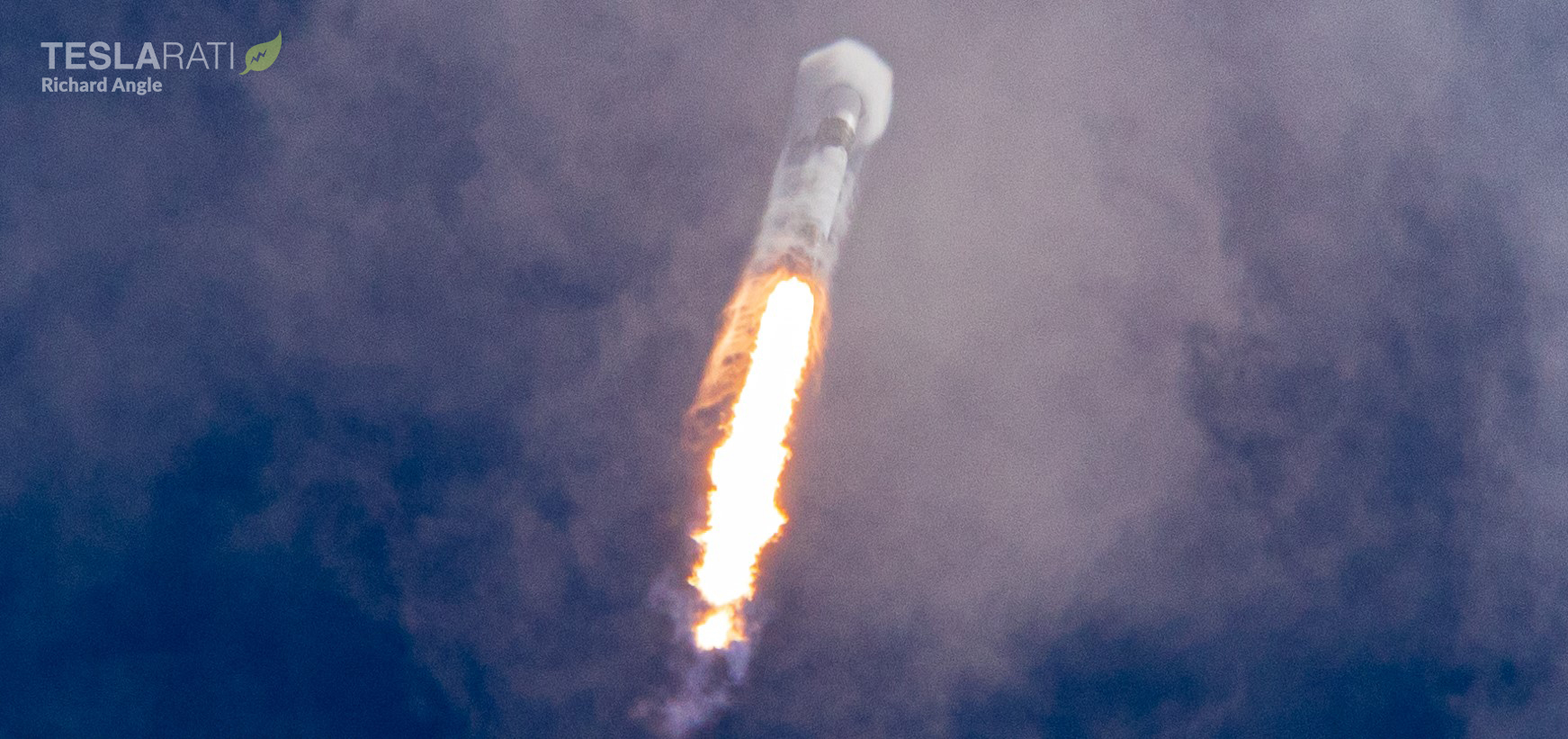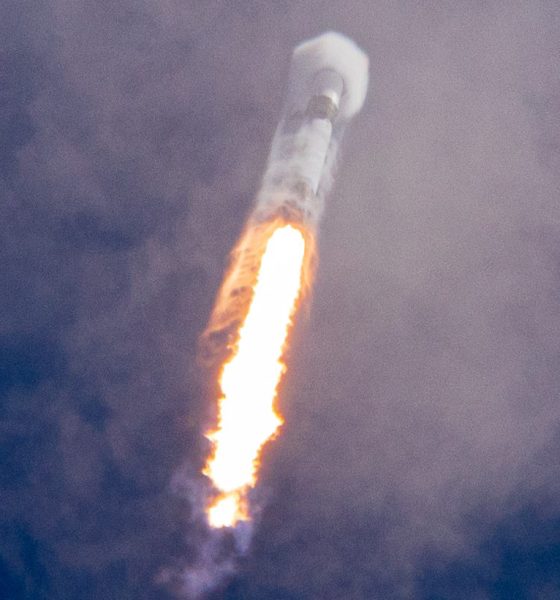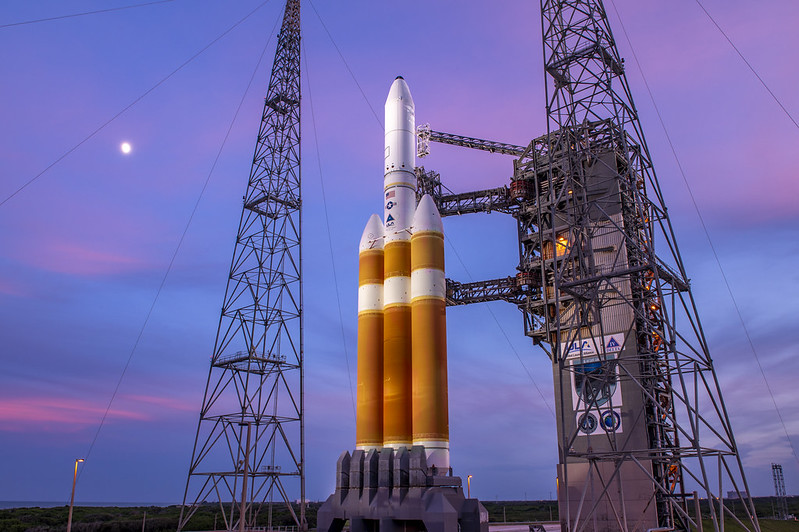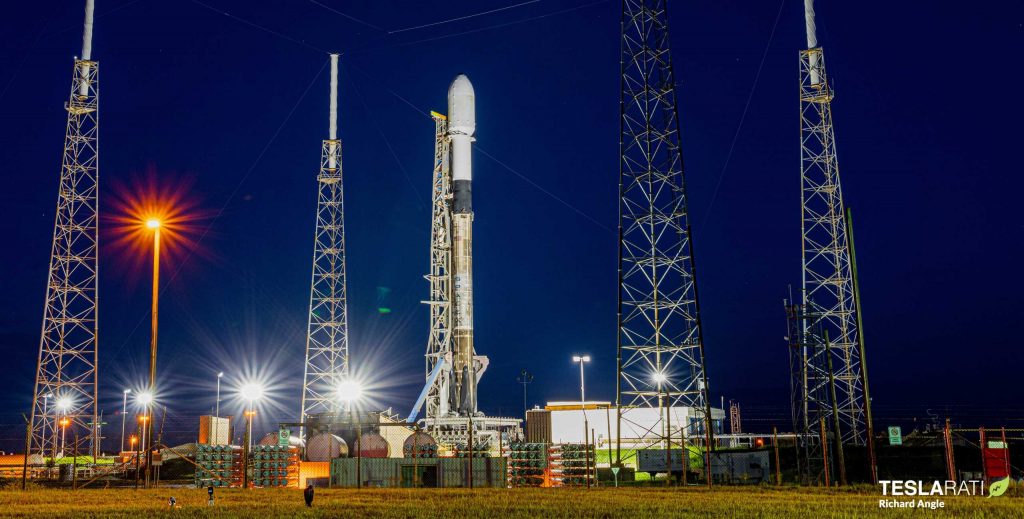

News
SpaceX Falcon 9 doubleheader still on track after fiery ULA launch abort
As previously reported by Teslarati, SpaceX announced intentions to launch two Falcon 9 missions from two Florida launchpads on Sunday, August 30th. However, the ambitious goal was left in limbo.
The record-breaking doubleheader was believed to hinge upon the Saturday morning launch of a United Launch Alliance (ULA) Delta IV Heavy rocket with a classified spy satellite. However, that is apparently no longer the case.
Instead of launching on time, ULA’s infrequently-flown heavy-lift rocket was hit by 72 hours of delays to rectify minor pad hardware bugs. Around 2 am EDT (UTC-4) on August 29th, Delta IV Heavy made it just seconds away from liftoff before the rocket’s autonomous flight computer detected an anomaly with pad hardware and aborted the launch. As a result, the three cores’ three Aerojet Rocketdyne RS-68A engines were forced to shut down after ignition – an uncommon Delta IV launch abort scenario that has historically required at least a week of work to recycle for another launch attempt.

ULA ultimately determined that it was not possible to recycle the countdown for another attempt although enough time remained in the launch window to do so. The launch vehicle was safed and a scrub was announced.
In a statement provided by ULA confirmed that the early shutdown was “due to an unexpected condition during the terminal count at approximately three seconds before liftoff.” ULA also confirmed that “the required recycle time prior to the next launch attempt is seven days minimum.”
ULA has to fly before SpaceX, right?
With a minimum of seven days required to recycle the ULA Delta IV Heavy for another launch attempt, it was unclear what that meant for the fate of the SpaceX SAOCOM-1B mission.

It was previously understood that in order for SpaceX to launch the SAOCOM-1B mission from nearby Space Launch Complex-40 (SLC-40), the ULA Delta IV Heavy would have to successfully launch first. The southern polar launch trajectory of the SAOCOM-1B’s mission is one that hasn’t been flown from Cape Canaveral, FL in nearly six decades. This particular flightpath includes launch hazard zones that inch ever so close to the launchpad of the Delta IV Heavy, which is currently still on its launchpad stacked with a classified payload for the U.S. government.
It was assumed that the Falcon 9 would suffer the same minimum delay of seven days, if not longer. However, on Saturday afternoon, August 29 a SpaceX media representative confirmed that the company was still targeting the historic double header launches on Sunday, August 30.
Double the launches, double the recoveries
If SpaceX can pull it off, Sunday is set to be a stellar day for Falcon 9 launches and landings. The SAOCOM-1B mission will feature a Return To Launch Site (RTLS) landing attempt of the expended Falcon 9 booster while the Starlink Falcon 9 booster is expected to land aboard the autonomous droneship “Of Course I Still Love You” currently stationed off the coast of South Carolina.
In an unusual move, SpaceX split up the fairing catching vessels. Initially, both vessels left Port Canaveral and headed south to a catch zone located between The Bahamas and Cuba in an attempt to catch both fairing halves of the SAOCOM-1B mission. Then, GO Ms.Tree did an about-turn and met up with the booster recovery vessels off the coast of South Carolina.
At the time of publishing, the two Sunday Falcon 9 launches are expected to occur just nine hours apart. The Starlink V1.0-L11 mission is slated to occur at 10:12am ET (1412 UTC) from Launch Complex 39-A at Kennedy Space Center while the SAOCOM-1B mission is set to launch at 7:18pm ET (2318 UTC) from SLC-40 at Cape Canaveral Air Force Station. As usual, SpaceX will host official launch webcasts live, typically beginning around 15 minutes before liftoff.
Check out Teslarati’s newsletters for prompt updates, on-the-ground perspectives, and unique glimpses of SpaceX’s rocket launch and recovery processes.

News
Tesla FSD fleet is nearing 7 billion total miles, including 2.5 billion city miles
As can be seen on Tesla’s official FSD webpage, vehicles equipped with the system have now navigated over 6.99 billion miles.

Tesla’s Full Self-Driving (Supervised) fleet is closing in on almost 7 billion total miles driven, as per data posted by the company on its official FSD webpage.
These figures hint at the massive scale of data fueling Tesla’s rapid FSD improvements, which have been quite notable as of late.
FSD mileage milestones
As can be seen on Tesla’s official FSD webpage, vehicles equipped with the system have now navigated over 6.99 billion miles. Tesla owner and avid FSD tester Whole Mars Catalog also shared a screenshot indicating that from the nearly 7 billion miles traveled by the FSD fleet, more than 2.5 billion miles were driven inside cities.
City miles are particularly valuable for complex urban scenarios like unprotected turns, pedestrian interactions, and traffic lights. This is also the difference-maker for FSD, as only complex solutions, such as Waymo’s self-driving taxis, operate similarly on inner-city streets. And even then, incidents such as the San Francisco blackouts have proven challenging for sensor-rich vehicles like Waymos.
Tesla’s data edge
Tesla has a number of advantages in the autonomous vehicle sector, one of which is the size of its fleet and the number of vehicles training FSD on real-world roads. Tesla’s nearly 7 billion FSD miles then allow the company to roll out updates that make its vehicles behave like they are being driven by experienced drivers, even if they are operating on their own.
So notable are Tesla’s improvements to FSD that NVIDIA Director of Robotics Jim Fan, after experiencing FSD v14, noted that the system is the first AI that passes what he described as a “Physical Turing Test.”
“Despite knowing exactly how robot learning works, I still find it magical watching the steering wheel turn by itself. First it feels surreal, next it becomes routine. Then, like the smartphone, taking it away actively hurts. This is how humanity gets rewired and glued to god-like technologies,” Fan wrote in a post on X.
News
Tesla starts showing how FSD will change lives in Europe
Local officials tested the system on narrow country roads and were impressed by FSD’s smooth, human-like driving, with some calling the service a game-changer for everyday life in areas that are far from urban centers.

Tesla has launched Europe’s first public shuttle service using Full Self-Driving (Supervised) in the rural Eifelkreis Bitburg-Prüm region of Germany, demonstrating how the technology can restore independence and mobility for people who struggle with limited transport options.
Local officials tested the system on narrow country roads and were impressed by FSD’s smooth, human-like driving, with some calling the service a game-changer for everyday life in areas that are far from urban centers.
Officials see real impact on rural residents
Arzfeld Mayor Johannes Kuhl and District Administrator Andreas Kruppert personally tested the Tesla shuttle service. This allowed them to see just how well FSD navigated winding lanes and rural roads confidently. Kruppert said, “Autonomous driving sounds like science fiction to many, but we simply see here that it works totally well in rural regions too.” Kuhl, for his part, also noted that FSD “feels like a very experienced driver.”
The pilot complements the area’s “Citizen Bus” program, which provides on-demand rides for elderly residents who can no longer drive themselves. Tesla Europe shared a video of a demonstration of the service, highlighting how FSD gives people their freedom back, even in places where public transport is not as prevalent.
What the Ministry for Economic Affairs and Transport says
Rhineland-Palatinate’s Minister Daniela Schmitt supported the project, praising the collaboration that made this “first of its kind in Europe” possible. As per the ministry, the rural rollout for the service shows FSD’s potential beyond major cities, and it delivers tangible benefits like grocery runs, doctor visits, and social connections for isolated residents.
“Reliable and flexible mobility is especially vital in rural areas. With the launch of a shuttle service using self-driving vehicles (FSD supervised) by Tesla in the Eifelkreis Bitburg-Prüm, an innovative pilot project is now getting underway that complements local community bus services. It is the first project of its kind in Europe.
“The result is a real gain for rural mobility: greater accessibility, more flexibility and tangible benefits for everyday life. A strong signal for innovation, cooperation and future-oriented mobility beyond urban centers,” the ministry wrote in a LinkedIn post.
News
Tesla China quietly posts Robotaxi-related job listing
Tesla China is currently seeking a Low Voltage Electrical Engineer to work on circuit board design for the company’s autonomous vehicles.

Tesla has posted a new job listing in Shanghai explicitly tied to its Robotaxi program, fueling speculation that the company is preparing to launch its dedicated autonomous ride-hailing service in China.
As noted in the listing, Tesla China is currently seeking a Low Voltage Electrical Engineer to work on circuit board design for the company’s autonomous vehicles.
Robotaxi-specific role
The listing, which was shared on social media platform X by industry watcher @tslaming, suggested that Tesla China is looking to fill the role urgently. The job listing itself specifically mentions that the person hired for the role will be working on the Low Voltage Hardware team, which would design the circuit boards that would serve as the nervous system of the Robotaxi.
Key tasks for the role, as indicated in the job listing, include collaboration with PCB layout, firmware, mechanical, program management, and validation teams, among other responsibilities. The role is based in Shanghai.
China Robotaxi launch
China represents a massive potential market for robotaxis, with its dense urban centers and supportive policies in select cities. Tesla has limited permission to roll out FSD in the country, though despite this, its vehicles have been hailed as among the best in the market when it comes to autonomous features. So far, at least, it appears that China supports Tesla’s FSD and Robotaxi rollout.
This was hinted at in November, when Tesla brought the Cybercab to the 8th China International Import Expo (CIIE) in Shanghai, marking the first time that the autonomous two-seater was brought to the Asia-Pacific region. The vehicle, despite not having a release date in China, received a significant amount of interest among the event’s attendees.








